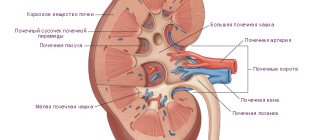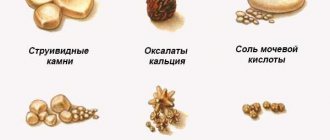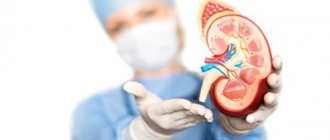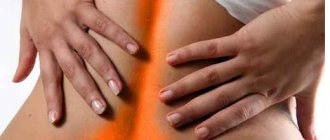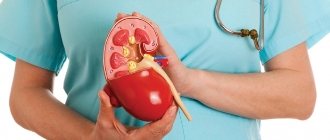What stones can pass on their own?
If there are stones (calculi) in the kidneys, a person experiences lower back pain, and blood may appear in the urine. However, not every case will require surgery.
According to various sources, in 70-75% of people stones up to 5 mm in size are able to pass on their own.
This process is accompanied by a set of symptoms called renal colic:
- severe, often unbearable pain in the lumbar region (right kidney);
- increased blood pressure;
- temperature increase.
The passage of the stone may take from several days to 2-3 weeks. If it is accompanied by long-term complications or malaise, it is better to consult a doctor immediately.
Reasons for the passage of stones
The reasons for the formation of kidney stones are well known - they are associated with metabolic disorders and the formation of clots of poorly soluble salts. The passage of a stone provokes:
- mechanical pressure from neighboring organs (tumor of the kidney, ureter);
- complications after various operations;
- inflammatory processes in the urinary tract due to diseases (periurethritis, hydronephrosis, kidney tuberculosis);
- blood clots in the veins of the kidney;
- congenital features of the genitourinary system.
Sometimes the process of stone passage is preceded by active physical activity, drinking large quantities of drinks and water.
Taking diuretic medications without a doctor’s recommendation also contributes to the movement of stones.
How a kidney stone passes: general symptoms
The main symptom is noticeably severe pain, which often becomes unbearable. Along with extraneous sensations, there are other symptoms that allow you to understand that the stone is coming out of the kidneys.
Pain and burning
Pain is the main symptom indicating the movement of kidney stones. The characteristics of pain are as follows:
- can be either dull or sharp (burning sensation);
- usually localized in the lumbar region;
- appears not only in the back area, but also under the ribs on the back side;
- lasts from 15 minutes to 1 hour;
- worsens after physical activity, with sudden movements and jolts.
Changes in urine
Certain changes also occur with urination and the composition of urine:
- little or no urine;
- frequent urge to pee;
- the appearance of blood impurities;
- white flakes in urine (loose, gelatinous texture);
- urine turns an unnatural color - reddish or dirty black.
In 65-70% of cases, similar symptoms appear in men. However, there are certain specificities in the signs of kidney stones in women. At the initial stage, the symptoms of the attack are similar. Subsequently, in men, pain symptoms spread to the scrotum and perineum, and in women - to the labia area.
Chills, temperature
A characteristic, but nonspecific symptom of kidney stones passing is an increase in temperature. It usually reaches from 37.2 to 38°C. But there are also cases when it rises a little higher. The person begins to shiver, as if he had a severe cold. If such symptoms persist for several days, it is recommended to consult a doctor.
Nervous system disorders
Signs of movement of kidney stones also appear from the nervous system:
- irritability;
- general fatigue, weakness;
- dizziness and heaviness in the head.
These symptoms are due to prolonged exposure to pain. Therefore, the first measure of assistance for colic is associated with mandatory pain relief.
Edema
Another sign of a stone leaving the kidney is swelling of the skin. This symptom is easily identified visually. Edema appears as a result of a malfunction of the kidneys. The stones that appear interfere with the normal excretion of urine, causing fluid to accumulate in the body.
High blood pressure
Failure of the kidneys leads to excess fluid accumulating in the body. It puts pressure on internal tissues, organs, and blood vessels. Therefore, an increase in blood pressure is observed (usually by 15 mm). Even if a person has always had normal blood pressure, with an exacerbation of colic, the upper blood pressure can reach 150-160 mm Hg. Art.
Digestive disorder
Disruption of digestive processes during colic is not always observed. However, signs of a stone leaving the ureter or kidney are also characteristic of inflammation of the pancreas, stomach, and gall bladder. The accumulation of fluid can lead to digestive disorders, which will manifest itself in pain, diarrhea, and intestinal spasms.
Why does renal colic appear and why is it dangerous?
It is also important that the disease can worsen at times, that is, renal colic can appear quite often. Typically, an attack of kidney stones may appear soon after a diet violation or consumption of foods that should not be consumed if you have this disease.
If this disease is not treated, then in the future kidney stones can lead to chronic pyelonephritis, acute or chronic renal failure, and kidney loss. That is, there is a real threat to the health and life of the patient.
What to do if a kidney stone passes
Colic due to stones occurs suddenly and can occur on the road or at work, so it is better to immediately call an ambulance. Before doctors arrive, first aid measures should be provided.
First aid
One of the main questions is related to what can be done at home if stones pass. First of all, a person is shown complete rest. You should sit him in a comfortable position and ventilate the room. You also need to take care of how to relieve pain if a kidney stone passes. For this purpose, antispasmodics are given (No-Shpa, Baralgin, Papaverine, Revalgin).
Place a heating pad on your lower back or take a warming bath. However, this can only be done if the person is completely sure that the pain is associated precisely with the movement of stones, and not with other reasons (sciatica, appendicitis, etc.).
Drugs
Further kidney treatment is prescribed by the doctor. The main method of therapy is taking medications in accordance with the instructions:
- Potassium citrate;
- Purinol;
- Spilled;
- Cyston;
- Asparkam et al.
Diet and lifestyle
Almost always, the doctor prescribes complex treatment, which is associated not only with taking medications. Other measures are also indicated:
- ensuring complete rest for several days or weeks;
- observation by a urologist;
- exclusion of strong physical activity;
- dieting.
You should drink only soft filtered water. As part of the diet, the following rules are followed:
- exclude any fatty, spicy, smoked, fried foods;
- do not consume chocolate and coffee;
- legumes are removed from the menu.
Folk remedies
Since colic is accompanied by a painful attack, patients are interested in what to do to make the kidney stone pass faster. As additional measures, along with the main course of therapy, folk remedies are also used, for example, decoctions:
- knotweed;
- chamomile;
- plantain;
- birch buds;
- parsley root and greens.
Brew at the rate of 1 tbsp. raw materials per glass of boiling water. They insist for half an hour. Take 2-3 large spoons over 30 minutes. before every meal.
Folk remedies are only an addition to the main course. Self-treatment is unacceptable, therefore, before using the product, a mandatory consultation with a urologist is necessary.
Kidneys are also treated:
- chopped burdock root (a tablespoon per glass of boiling water);
- natural cold-pressed pomegranate juice;
- decoction of corn silk (3 large spoons per glass of boiling water);
- watermelon (in the summer season);
- freshly squeezed vegetable juices based on pumpkin, horseradish, radish, asparagus (both individually and in a mixture).
Surgery
The decision about kidney surgery is made by the doctor based on the following indications:
- constant unbearable pain that cannot be treated with conventional methods (medicines, folk remedies);
- obstruction of the urinary tract;
- inflammatory processes in the kidneys with complications, pus;
- Kidney carbuncle – partial death of tissue.
The decision can be made at the request of the patient, but in any case, the approval of a urologist is required.
Exercises
Along with taking medications and using folk remedies, you can also do simple physical exercises:
- Walking at an accelerated pace. Walking with a high knee lift or on a straight leg.
- Regular easy jogging or jogging with knees raised. The pace is according to how you feel.
- Jumping in place and forward, a combination of jumping and running, alternating with walking according to how you feel.
- Any exercises with a skipping rope.
- Swing your legs and arms in different directions.
- Body rotations.
- Stepping over a stool.
These exercises help remove stones. However, their use must be agreed with a doctor.
Consequences of stones leaving the renal pelvis
The most common consequences of this phenomenon include:
- temperature about 37.2-38°C;
- general malaise;
- foreign sensations in the lower back;
- symptoms of the inflammatory process (pyelonephritis) - nausea, vomiting, pain when urinating, chills.
The movement of stones in the ureter is accompanied by pain both during exit from the kidney and after that. Therefore, at first it is better to consult a urologist in order to adequately assess your condition and, if necessary, undergo a course of treatment.
Urolithiasis in children
Unfortunately, recently children have been suffering from urolithiasis very often. The main reasons for this:
heredity; intrauterine development defects; consequences of past infectious and inflammatory diseases; poor nutrition.
The first signs of stone formation in a child’s body are dysfunction of the parathyroid glands or digestive system. If they are detected, it is necessary to examine the child for urolithiasis.
Important questions
People suffering from urolithiasis always have questions related to the duration of stone removal and the consequences of this process.
How long does it take for a stone to come out?
The period may take from several days to 2-3 weeks. But delays are possible due to the size of the stones. Therefore, the answer depends on the person’s condition.
What to do if a pebble comes out when urinating
In this case, it is better to immediately contact a urologist in order to adequately assess the condition of the kidneys and the genitourinary system as a whole. In most cases, stones do not exceed a centimeter in diameter. You should not throw them away - it is better to save them for demonstration to the doctor.
How long does the pain last after the stone passes?
Pain lasts for 1-1.5 hours and is usually relieved with antispasmodics. But as a result of complications against the background of inflammatory processes, pain and cramping may appear after this for several days.
Why did the temperature rise after the stone passed?
The phenomenon may be due to the fact that other stones, larger or smaller, remain in the ureter. Also, an increase in temperature occurs due to ongoing inflammatory processes in the kidney and ureter. In any case, you should not self-medicate - it is important to consult a urologist as soon as possible.
How to understand that a stone has passed
The main sign of stone movement is severe pain, that is, symptoms of renal colic. When the pebble is completely released into the bladder, the extraneous sensations stop and the state of health noticeably improves. The release of a calculus is independently determined by the fact of its appearance as a result of urination.
The movement of the stone is always associated with severe pain. First of all, you need emergency help - antispasmodic drugs. In the future, at the first opportunity, you should consult a doctor to understand how to speed up the passage of the stone, and whether surgery is necessary.
Treatment
This is how they are removed from the ureteral canal
- Treatment of urolithiasis is carried out in two ways: conservative treatment and surgical intervention (operation). Conservative treatment is indicated only when the patient’s health is not in a critical condition: when the stone is small in size and has a smooth surface. In this case, the doctor prescribes drugs whose action is aimed at dissolving the stone. It is worth considering that drugs are selected individually, depending on the composition of the stone. Also, the patient is prescribed a special therapeutic diet, with the exclusion from the diet of foods that contribute to the formation of stones. So, for example, with oxalate stones, the patient should not eat sorrel and similar products. In addition, the patient should drink a large amount of fluid, approximately 2 liters per day. As a rule, it should be mineral water without gas. However, you should not drink coffee, strong tea or alcoholic beverages. If the formation of stones was contributed to by another inflammatory-infectious disease of the genitourinary system, or the disease occurs in parallel (for example, pyelonephritis), then the patient is prescribed antibiotics and anti-inflammatory drugs.
- If conservative therapy is ineffective or in advanced cases, stones are removed surgically. Doctors try to make this decision as a last resort, since any operation is a risk. However, compared to previous years, when only open operations were performed, medicine has now made many steps forward. Previously, such operations often ended with the removal of the stone-affected organ, but now in most cases the organ can be preserved. In addition, there is an alternative to surgery, such as laser stone crushing.
There are often cases when stones reach a size of more than 10 mm and completely block the ureter. In this case, a procedure is performed to remove urine from the patient’s kidneys. In medical practice, such a procedure is perceived as an operation that is performed under general anesthesia.

